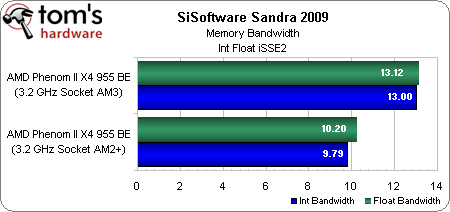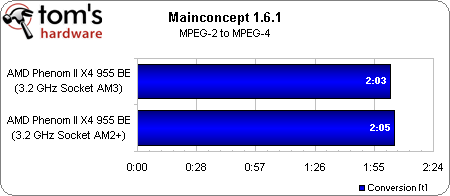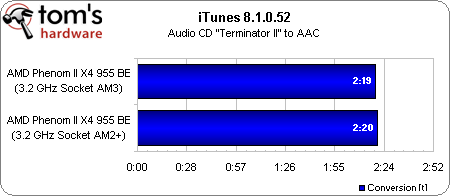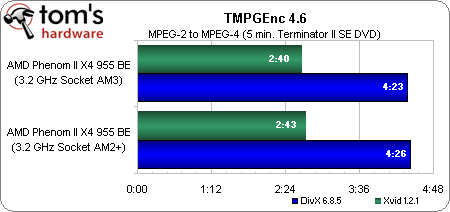Phenom II X4 955: AMD's Dragon Platform Evolves
DDR2 Versus DDR3
One of the things we didn’t do in our Socket AM3 launch story (and subsequently received a number of requests for) was to test the same CPU in Socket AM3 and Socket AM2+ interfaces to assess the specific benefits of adopting DDR3 memory right away, if there were any. Thus, we have those numbers here.
We tested the new Phenom II X4 955 (at 3.2 GHz) using Asus’ M3A78-T, a 790GX-based Socket AM2+ board running BIOS 0903, and Asus’ M4A79T Deluxe, a 790FX-based Socket AM3 motherboard running BIOS 0902. The AM2+ platform was rocking 4 GB (2 x2 GB) of our fastest Corsair DDR2-1066 with CAS 5-5-5 timings. The AM3 system featured 4 GB (2 x2 GB) of Corsair DDR3-1600 (running at 1,333 MT/s) with 8-8-8 timings.
The first performance metric, SiSoftware’s new Sandra 2009 with SP3, demonstrates the throughput advantage of DDR3 on the same processor. As we’ll see on the next page, overclocking the memory yields even more raw throughput. But for our purposes, we’ll compare the highest memory speeds officially supported by AMD’s integrated controller.
Encoding apps are some of the most demanding, and here we see Mainconcept favoring the DDR3-based configuration just slightly. Early on, it’s worth noting that transitioning from DDR2 to DDR3 is most definitely not worth it if you're already using a Spider or Dragon system. However, as prices on DDR3 come down (as they have been), enthusiasts who’ve held off on any upgrade will probably want to lean in the direction of the newer technology. As happened with DDR, DDR2’s days were numbered as soon as AMD and Intel both started enabling DDR3 on their respective platforms.
Though certainly less demanding than most of our other tests, iTunes is at least one of those apps that many of us use on a regular basis. This CD conversion runs one second faster on the AM3 board. Though hardly a noticeable improvement, the trend continues.
Both our DivX and Xvid conversions are cut down by three seconds in the shift to DDR3 memory. Again, this is by no means a decisive victory. But it does remind me of a story I wrote back in 2000 about AMD, its 760 chipset, and the move to DDR. The benefits might be small today, but expect the architecture to become ever more reliant on memory bandwidth as DDR3 adoption increases.
The good news is that 4 GB kits of CAS 8 DDR3-1333 are priced around $70—certainly not as high as the horrid prices that used to plague the technology. Just bear in mind that if you buy higher-voltage modules today as a cost-saving measure, you won’t be able to use them down the road should you switch over to a Core i7-based machine, which can be damaged at voltages over 1.65V.
Get Tom's Hardware's best news and in-depth reviews, straight to your inbox.
Current page: DDR2 Versus DDR3
Prev Page AMD Phenom II X4 955: Finally, A Flagship Next Page Overdrive 3.0 And Another Acronym-
inmytaxi Why call a 955 $255 plus 790GX mb $110 plus 4 gb ram $41 is $500, when it's actually $410 before shipping and rebates, which about cancel out? And that's just picking off the cheapest at newegg and not price shopping, which might knock it below $400.Reply
Not to mention the six months on the market the other set up has had to drop in price ... -
inmytaxi Of course, even at NewEgg, the i7 is still just a benny more, at $280 for the i7, $84 for 1600 6gb ram and $200 for a MB. What's, $564 before ship and rebates, knock $50 if you get the i7 at microcenter, and another $20 on real cost after nit picking out shipping and rebates ... and settle for 1333 ram ... you're within fifty bucks!!!Reply
If it wasn't for that Nvidia issue with the i7 ...
Hell, -
inmytaxi Hell, you can knock seventy off the hundred dollar price diff. with an open box motherboard for one thirty instead of twoo hundred.Reply
Nice processor, but until the price drop comes the only reason to buy it is if you're upgrading. If you're doing a clean sweep it's the i7 all the way.
-
gsacks inmytaxiHell, you can knock seventy off the hundred dollar price diff. with an open box motherboard for one thirty instead of twoo hundred.Nice processor, but until the price drop comes the only reason to buy it is if you're upgrading. If you're doing a clean sweep it's the i7 all the way.Reply
Not fair. Don't compare open box prices to new prices. If you want to buy used/refurb/reconditioned/open box, then compare the prices against the same used/refurb/reconditioned/open box equivalent for the other platform. Otherwise, you are fudging your numbers.
-
trevorvdw "The only standout in this clumsy console port is AMD’s Phenom II X3 720, which lags at both 1680x1050 and 1920x1200. The rest of the processors serve up reasonably close performance, per what we’ve come to expect from Grand Theft Auto 4."Reply
Yeah that whole less than 10% behind the i7 920 is totally lagging and not close in performance... who writes this drivel? -
for gamers: seriously, get the 720BE and oc it to death. then spend your money on VIDEO CARD(S)... that's what's important here!Reply




